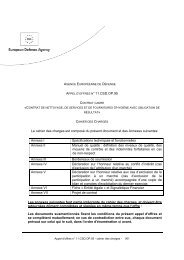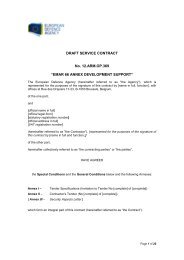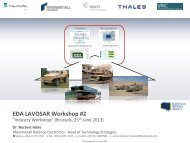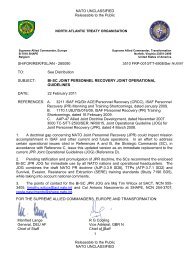capability development plan - European Defence Agency - Europa
capability development plan - European Defence Agency - Europa
capability development plan - European Defence Agency - Europa
Create successful ePaper yourself
Turn your PDF publications into a flip-book with our unique Google optimized e-Paper software.
IMPACT OF SCIENCE AND TECHNOLOGY ON FUTURE<br />
CAPABILITIES DEVELOPMENT<br />
Power sources for soldier systems are an important issue. This is discussed as part of the domain of<br />
knowledge and networking.<br />
47<br />
Weapon systems – destructive effects. The main S&T trends are related to using weapon systems<br />
together with sensor and network data in order to better produce the desired effects, which may both<br />
be destructive (lethal) and non-destructive (non- or less lethal).<br />
In terms of destructive effects, this primarily means continued evolutionary <strong>development</strong>s of precision<br />
guided munitions (PGMs) for increased precision, lower failure rates and resilience against<br />
countermeasures, in order to reduce collateral damage and the risk of fratricide. There is however also<br />
some <strong>development</strong>s directed at introducing new kinds of effects or “weapon cores”, better suited to<br />
achieving appropriate destructive effects for future operations. This includes weapons for self-defence<br />
purposes, intended for the protection of platforms.<br />
If fully pursued, new <strong>development</strong>s in the area of novel energetic materials could lead to increased<br />
weapon performance by using increased explosive performance (expected to be 20-25%):<br />
- It is possible to increase in armour penetration of up to 60% by use of new liners in Shaped Charge<br />
Jet (SCJ). This would make it possible to produce much smaller and lighter AT weapons with the same<br />
performance as today, which would be of relevance to dismounted soldiers as well as to small-size<br />
unmanned vehicles.<br />
- It is possible to develop weapons based on Enhanced Blast Explosives (EBX), using novel energetic<br />
materials and different metals (possibly made more reactive), to enhance effects in confined spaces<br />
and urban warfare. This could be used for small, man-possible weapons with exceptional performance<br />
for urban warfare e.g. larger blast effect in a confined area and less collateral damage outside this area<br />
(because of less shrapnel). Another use for this technology is large bombs with exceptional<br />
performance in heavily fortified enemy strongholds (caves, bunkers).<br />
- Other <strong>development</strong>s in the novel energetic materials could mean more gradual increases in the<br />
<strong>capability</strong> of new weapons: increase in range of rocket engines up to 50%, increase in performance of<br />
underwater weapons (such as torpedoes or mines) up to 25% (plus effects of using EBX), or increase<br />
in muzzle velocity of guns leading to better penetration, increased range, shorter in flight time resulting<br />
with better hit probability.<br />
Besides the well established kinetic energy weapons and explosives, a completely new family of<br />
weapons, Directed Energy Weapons (DEW), is emerging. DEW mainly takes the shape of High Power<br />
Microwaves (HPM) and laser weapons. In general, DEW can be used for both destructive and nondestructive<br />
purposes, depending on the power of the weapon and for which purpose it is used. Some<br />
DEW systems are useful for both purposes, if they are given a tuneable effect, while some will only be<br />
useful for a narrower purpose.<br />
Avior, laser system characterised by unlimited depth of definition, a high degree of colour diversity, brightness and constant colour<br />
convergence - developed by Rheinmetall <strong>Defence</strong> Electronics © Rheinmetall <strong>Defence</strong> Electronics<br />
Two attractive aspects of DEW is that the energy beam travels with the speed of light (although the<br />
weapon system could still take time to aim and to fire up) and that DEW do not consume ammunitions<br />
as such. They do however require significant energy supply and high-power DEW will likely consume<br />
more electrical power than any other mobile system in service installed. The power source aspects<br />
need to be taken into account when the total system size and logistics footprint of DEW is estimated,<br />
which makes the future role of DEW still uncertain – wide applicability or niche.<br />
The effect of HPM is to destroy or disrupt electronics, such as that of an incoming missile, while laser<br />
weapons either blind optical sensors of platforms or weapons, or heat up their target to achieve a<br />
disruptive or destructive effect, such as prematurely igniting the warhead of an incoming weapon. HPM<br />
effects are mainly short-range but need not be as carefully aimed, while laser weapons are long-range<br />
but are dependent on careful aiming to achieve their effects.<br />
Close-range self-protection of valuable platforms against incoming weapons could be achieved by<br />
integrated HPM functionality into the platform, provided that the electronics systems of the platform will<br />
not be harmed when the HPM is engaged.<br />
Other uses to which HPM charges or weapons may be put include clearance of mines and IEDs, and<br />
disruption of adversaries’ electronics equipment, such as communication systems and radars.<br />
FUTURE TRENDS FROM THE CAPABILITY DEVELOPMENT PLAN

















